Research Article Open Access
Effect of Bacterial Application on Metal Availability and Plant Growth in Farmland-Contaminated Soils
| Du RY, Wen D, Zhao PH, Chen Y and Wang FH* | |
| Public Monitoring Center for Agro-Product, Guangdong Academy of Agricultural Sciences, Guangzhou 510640, China and Key Laboratory of Testing and Evaluation for Agro-product Safety and Quality, Ministry of Agriculture, Guangzhou 510640, China | |
| *Corresponding Author : | Wang FH Public Monitoring Center for Agro-Product Guangdong Academy of Agricultural Sciences Guangzhou 510640, China E-mail: wfhwqs@163.com |
| Received: January 21, 2016 Accepted: February 05, 2016 Published: March 11, 2016 | |
| Citation: Du RY, Wen D, Zhao PH, Chen Y, Wang FH (2016) Effect of Bacterial Application on Metal Availability and Plant Growth in Farmland-Contaminated Soils. J Bioremed Biodeg 7:341. doi: 10.4172/2155-6199.1000341 | |
| Copyright: © 2016 Du RY, et al. This is an open-a ccess article distributed under the terms of the Creative Commons Attribution License, which permits unrestricted use, distribution, and reproduction in any medium, provided the original author and source are credited. | |
Visit for more related articles at Journal of Bioremediation & Biodegradation
Abstract
Conventional approaches for phytoremediation of heavy metal-contaminated soils face challenges in farmland werlands. The combined use of functional microorganisms is a promising option to enhance phytoremediation. Two heavy metal-resistant model strains, designated DBM1 (rhizosphere Arthrobacter) and DBM2 (non-rhizosphere Bacillus), were isolated from polluted farmland soils downstream of a multi-metal mine. The effects of these two bacterial strains on soil metal availability and plant (rice and red ramie) growth were determined under greenhouse conditions. Both microbes (especially DBM2) significantly reduced metal availability and increased pH level in lowcontaminated soil, but the passivation ability of DBM2 disappeared in high-contaminated soil. Soil metal availability was markedly increased by DBM1 after addition of carbon source, while it was reduced by DBM1 or DBM2 with pH increase after addition of nitrogen, phosphorous, or modified fly-ash amendment. Both microbes significantly increased plant biomass and reduced total metal contents of low-metal accumulating rice. For high-metal accumulating red ramie, DBM1 significantly increased plant biomass while DBM2 increased total metal contents. Proper selection of microbial species to match plants for phytoremediation is the key to improve microbe-assisted phytoremediation efficiency in mining-contaminated soils.
| Keywords |
| Arthrobacter; Bacillus; Microbe-assisted phytoremediation; Soil contamination; Metal availability; Plant growth |
| Introduction |
| Ecological problems caused by mine exploitation have become global [1-3]. An example is from the Dabaoshan Multi-metal Mine in Guangdong Province, China, where mineral resources are characterized by complex paragenetic associations with a variety of metal elements such as Pb, Cd, Cu, Zn, and As [4]. As a consequence, either the heavily contaminated mining wasteland or the moderately contaminated downstream agricultural soil is commonly associated with multiple toxic metals [5]. |
| Dynamic interactions between concomitant heavy metals can lead to changes in the ecotoxicity of mining-contaminated soils, as well as affect the form and bioavailability of metal contaminants [4]. These problems bring enormous difficulty in applying conventional remediation technologies to remediation of heavy metal-contaminated soils. Compared with conventional chemical and physical treatments, phytoremediation is an advantageous option that is cost-effective, environment-friendly, capable of maintaining soil productivity, and free of secondary contamination [6]. However, simple application of plant remediation techniques has failed in ecological remediation of combined contamination, Because the heavy metal contaminated soil lead pH, nutrient matter content, microorganisms activity were 51 lower and the known hyperaccumulators plant often have relatively low biomass or limited accumulation of heavy metals in contaminated mining areas. This situation urges the use of chemical enhancers or fertilizers to improve the efficiency of phytoremediation, thus increasing the cost of remediation and bringing the risk of secondary pollution [7-9]. |
| Soil microorganisms are mediators in the biogeochemical cycling of nutrient elements in terrestrial ecosystems. A diversity of bacteria is involved in the migration and transformation of heavy metals in the soil [10]. There is increasing evidence that microbial components play an important role in phytoremediation of mining-contaminated soils. More than 20 species of rhizosphere bacteria (e.g., Pseudomonas, Bacillus, Rhizobium, and Serratia) are known to have a positive role in plant establishment and colonization on mining wastelands, mainly by increasing plant nutrient uptake and improving the soil structure [11]. Soil microorganisms, especially the rhizosphere microflora, utilize the nutrients secreted by plant roots and in turn provide metabolites to facilitate plant growth. Moreover, microbial active substances such as extracellular enzymes, organic acids and chelates convert soil heavy metals from the unavailable to bioavailable forms, promoting their uptake and accumulation by plants. Compared to chemical enhancement, the biological enhancement of phytoremediation is obviously associated with lower cost and environmental risk the soil environmental quality will be affect plant growth. Therefore, microbeassisted phytoremediation has become a hot topic for research on the remediation of heavy mental-contaminated soils [7,9,12,13]. |
| Heavy metal-tolerant microbes are frequently isolated from mining-contaminated soils at low pH and high concentrations of multiple heavy metals. Although such environments are lethal for ordinary microbes to live in, specific genes in the tolerant microbes can be activated under extreme conditions, inducing unique biological metabolic pathways for survival. In practical applications, functional microbes can be isolated from mining-contaminated soil and then applied back into the original or adjacent soil via expanded propagation. This microbe-assisted method is reported to enhance the remediation of heavy metal-contaminated soil compared with non microbial treatment [14]. However, the effect of microbial function on soil metal availability and plant growth in heavy metal-contaminated soils has not been fully elucidated. The influence mechanism will be change with the different functional microorganisms combined the different plants are different. |
| Isolated two functional bacterial strains from rice and red ramie root plant in polluted farmland soils downstream of a multi-metal mine in preliminary studies. Found that two strains can still grow normally in the high concentration of heavy metal treatment. So through research the bacterial functional in the different levels of soil contaminations, and combined with rice and red ramie. Analysis their effects on soil metal availability and plant growth were examined under greenhouse conditions. The results will provide reference data for microbe-assisted phytoremediation of mining-contaminated soils. |
| Materials and Methods |
| Study site |
| The Dabaoshan Mine is a large multi-metal mine in Shaoguan City, Guangdong Province, China. Its main orebody consists of limonite ore in the upper part (20 million ton reserves) and large copper ore in the lower part (28 million ton reserves). Associated rare and noble metals include tungsten, bismuth, molybdenum, gold, and silver. The primary finished products are iron ore, copper concentrate ore and grade 1 electrolytic copper [15,16]. In the process of mining, the S2- with the copper ore will be oxidized into H2SO4. Accompanied by the efflux of mineral water lead the surroundings farmland soil pH value is very low. |
| Since 1970, the Dabaoshan Mine has experienced large-scale exploitation. Over the past four decades, due to lack of environmental awareness and unplanned, disorganized exploitation of individual miners, local vegetation has largely been destroyed while substantial heavy metals and high concentrations of sulfates are produced from oxidation of metal sulfides. The mining waste products caused serious contamination in the vicinity, especially the eco-environment of Hengshi River Basin. Heavy metal contamination also brought disastrous consequences to local agricultural production and people’s health [17]. |
| Soil sampling and physicochemical analysis |
| Along the drainage channel, mining wastewater often outflows during the rainy season, resulting in downstream farmland contaminating in the vicinity. Soil sampling was conducted at two points of different distances from the drainage channel: 20 m as the high-contaminated sampling point and 200 m as the low-contaminated sampling point. |
| Soil samples (1000 g each) were taken from the surface down to a depth of 20 cm using a wooden spatula. Each sample was divided into two portions, one stored at 4°C for bacterial isolation, and the other air-dried for physicochemical analysis. Plant residuals and stones were removed by hand, and soil samples were passed through a 1-mm sieve prior to soil physicochemical analysis. |
| The air-dried soil was sieved and digested with HCl-HNO3-HClO4 (3:1:2, V/V/V). Total soil concentrations of Cd, Pb, Cu, Mn and Zn were determined by inductively coupled plasma-optical spectrophotometry (ICP-MS, Agilent 7700X, USA). Soil pH and organic matter content were determined using standard methods for soil agro-chemical analysis [18]. The major physicochemical properties of the test soils are shown in Table 1. |
| Bacterial isolation and identification |
| For bacterial isolation, soil samples were collected from rhizosphere and adjacent non-rhizosphere soils of Jatropha curcas L and Hibiscus cannabinus L. Up to 10.00 g of mixed fresh soil (highand low-contaminated) was added into a triangular flask containing 90 mL sterile water and ten 3-5-mm glass beads. Cd, Pb, Cu and Zn are the main pollutants in farmland soil. The soil suspension was shaken at 160 rpm·min-1 for 30 min at 28°C and then inoculated to a solid beef-extract-peptone medium containing Pb2+ (1000 mg·kg-1), Cd2+ (20 mg·kg-1), Cu2+ (800 mg·kg-1), Zn2+ (1000 mg·kg-1), and other heavy metals. Pb2+, Cu2+, Zn2+ and Cd2+ concentrations in the medium were designed based on total metal concentrations in farmland soils surrounding the Dabaoshan Mine area according to our research group investigate. |
| The inoculated plates were incubated at 30°C for 3-7 days. Isolated single colonies were chosen and fully grown to obtain a pure culture using the streak plate method. After incubation (three passages) with the heavy metal-containing medium, two purified rod-shaped bacteria resistant to high concentrations of Cd, Zn, Cu, and Pb were obtained [11]. The main purpose is to screen functional bacteria. Cd, Pb, Cu and Zn are the main pollutants in farmland soil. So add those into culture medium for screen stronger functional bacteria. Then the bacteria were cultured and purified. These two isolates were identified based on 16S rDNA sequences by the Microbiology Institute of Guangdong Province, Guangzhou, China. One was Arthrobacter sp. DBM, referred to as DBM1, and the other was Bacillus sp. DBM, referred to as DBM2. |
| Bacterial growth experiments |
| To eliminate the impact of broth medium on the experimental results, the culture broths of DBM1 and DBM2 were diluted with sterile water to obtain bacterial cell suspensions with an optical density at 600 nm (OD600) of 0.5. The suspensions (1 mL) were dispensed into 50- mL centrifuge tubes containing 1.00 g of high- or low-contaminated soil sample each. The mixtures were incubated at 30°C for 7 days by shaking at 200 rpm. Three replicates were prepared for each treatment. After the growth experiment, the concentrations of available heavy metals and the level of pH in the soils were determined as described above. |
| For parallel experiments, sterilized (121°C-heated, 2 h) highcontaminated soil weighing 1.00 g was added into 50 mL centrifuge tubes. Then, filter-sterilized glucose solution was added as carbon source, urea as nitrogen source, and KH2PO4 as phosphorus source (N0.08 g·kg-1, P2O5 0.08 g·kg-1, K2O 0.16 k·kg-1; 1 mL each). Three replicates for each treatment were prepared. Additionally, the high-contaminated soil was mixed with fly ash (Zhujiang Cement Plant, Guangzhou, China) to equilibrium for one month and then sterilized as a modified treatment. Approximately 1 mL of bacterial suspensions of DBM1 and DBM2 (OD600=0.5) was separately added to each treatment. The mixtures were incubated at 30°C for 7 days by shaking at 200 rpm. The concentrations of available heavy metals and pH level in the soil were then determined as described above. |
| Plant growth test |
| Rice and red ramie seeds were purchased from Agro-technical Station, Wengyuan County, Guangdong Province. Five rice (or red ramie) seeds were sown in 200-mL plastic containers containing 150 g of steam-sterilized soil. Each container was inoculated with 2 mL of bacterial suspension (DBM1 or DBM2, OD600=0.5). The control was inoculated with an equal volume of distilled water. Three replicates for each treatment were made. The plants were incubated in a greenhouse under natural light conditions. Up to 1 mL of bacterial suspensions were inoculated into each cup every other week, along with 1 mL of deionized water. After 30 days, plant biomass (fresh and dry weights of shoots and roots) and total contents of available heavy metals were determined. |
| Data analysis |
| Data were expressed as the mean ± standard deviation (n=3). Data comparison between treatments was performed using the analysis of variance. Multiple comparisons were performed using Duncan's multiple range test. The relevance between soil pH and heavy mental availability was examined using Pearson correlation analysis. P values less than 0.05 were considered statistically significant. SPSS 11.0 (SPSS Inc., Chicago, IL, USA) was used for data analysis. |
| Results |
| Metal availability and pH level in mining-contaminated soils |
| In the low-contaminated soil, the availability of Al, Cu, Fe, Pb, Zn, and Mn was significantly reduced due to the presence of DBM1 and DBM2 compared with that in the control. The reducing effect of microbes on heavy metal availability was most significant for Al and Pb, with approximately 6.5- and 3.5-fold differences, respectively. The capability of DBM1 to passivate heavy metals (except Cu) was slightly stronger than that of DBM2, but the differences were not statistically significant (Figure 1a). |
| In the high-contaminated soil, DBM1 significantly reduced the availability of heavy metals tested, except for Mn. The passivation capability of DBM2 to these heavy metals was weaker than that of DBM1, which only significantly affected Al and Fe availability (Figure 1b). |
| DBM1 and DBM2 raised soil pH to different levels, with greater pH increase in the low-contaminated soil (P<0.05 for both microbes) than in the high-contaminated soil (P<0.05 for DBM1 only, Figure 2). The capability of DBM1 and DBM2 to raise soil pH was almost identical in the low-contaminated soil (P<0.05). No significant pH increase was observed in the high-contaminated soil in the presence of DBM2 compared the control (P>0.05, Figure 2). |
| The relevance analysis showed that soil pH was significantly negatively correlated with metal availability (P<0.01). By contrast, there were significant positive correlations between the availability of different metals (P<0.01 or 0.05; Table 2). |
| Metal availability and ph level in mining-contaminated soils after addition of nutrients and modified amendment |
| The interaction between functional microbes and multiple metals changed after addition of C, N, and P sources and modified amendment (Table 3). With extra C source, DBM1 significantly enhanced the availability of most metals (P<0.05) except for Pb and Zn, whereas DBM2 significantly reduced the availability of most metals (P<0.05) except for Mn. After the addition of N source, P source, or modified amendment, both DBM1 and DBM2 significantly reduced the concentrations of available metals by 1.5- to 590-fold compared with the control (P<0.05). The extent of metal availability reduction by microbes generally decreased as N>P>modified amendment, except for Cu (modified amendment>N>P). |
| After the addition of N source, P source, or modified amendment, both DBM1 and DBM2 significantly raised soil pH. However, no significant change was observed in soil pH after the addition of C source (Table 4). The relevance analysis showed that soil pH was significantly negatively correlated with available metal concentrations, with the correlation coefficients of -0.943, -0.912, -0.862, -0.961, -0.961, and -0.906 (P<0.01). |
| Plant biomass and metal absorption |
| DBM1 and DBM2 had different effects on plant biomass of rice and red ramie grown in contaminated soils (Table 5). For rice, DBM2 increased plant biomass significantly more than DBM1 (P<0.05). For red ramie, DBM1 increased plant biomass (P<0.05) while DBM2 reduced plant biomass to different extents compared with the control (P<0.05 or>0.05). |
| DBM1 and DBM2 showed different effects on metal absorption capacity of plants. DBM1 increased Cu, Zn, Fe, and Al contents but decreased Pb and Mn contents in rice roots, whereas DBM2 generally reduced metal contents in rice shoots and roots (Figure 3). Red ramie gained increased Al, Fe, and Pb contents after inoculated with DBM1 or DBM2. Additionally, DBM2 increased Cu, Mn, and Zn contents, whereas DBM1 showed opposite effects on metal contents in red ramie (Figure 4). |
| Discussion |
| Slow growth, low biomass, and even failure of growth are the major issues encountered in phytoremediation around mining wastelands due to poor soil fertility and heavy metal toxicity [19]. In order to survive in heavy metal-contaminated soils, functional microbes [20] have to alter their metabolic activities with the ambient environment [8,13]. In this study, DBM1 and DBM2 exhibited strong ability to reduce heavy metal availability in mining-contaminated soils. DBM1 as rhizobacteria strongly reduced heavy metal availability and increased the pH in both high- and low-contaminated soils. However, the metal passivation ability of non-rhizobacteria DBM2 disappeared in the high-contaminated soil although it still increased soil pH (Figure 1). The increase in soil pH by functional bacteria could be attributed to their secretion of alkaloids [21], which inevitably led to decrease in metal availability. Although it remains unclear why DBM2 failed to reduce soil metal availability under high contamination, the results indicate that rhizosphere microorganisms play a more important role in the process of phytoremediation of heavy metal-contaminated soils [12,22,23]. |
| Microbes can affect the availability of heavy metals through direct or indirect metabolic activities, which play a decisive role in maintaining soil function. Alvareng (2009) reported that microbial activities were negatively correlated with Cu, Pb, and Zn availability. In the present study, we observed that following the addition of C source, soil metal availability was strongly increased by DBM1 in the contaminated soil. Especially, the increase of available Fe concentration (Table 3) could be attributed to secretion of siderophores by the rhizosphere bacteria [24,25]. In a microbial habitat, high C/N ratio often leads to gradual decrease in the pH, while low C/N ratio is associated with increases in the pH [26]. In the present study, glucose was added as the C source which did not help increase soil pH value (Table 4). The lower pH possibly induced specific metabolic pathways and triggered secretions of special metabolites to increase metal availability in the soil [27], thereby facilitating metal solution through directly and/or indirectly. |
| In contrast, the addition of N source, P source, or modified fly-ash amendment raised soil pH to different extents (Table 4), thereby reduces the toxicity of contaminated soil to microbes [14]. Additionally, the N and P sources increased their availability in a suitable range of soil pH (Table 4), which could benefit microbial growth and reproduction. Moreover, N and P sources might stimulate specific metabolic pathways of soil functional bacteria, further increasing the pH of soil solution. These hypotheses explained the decrease in soil metal availability upon the addition of N or P source in the presence of functional bacteria (Table 3). |
| An increasing attention is paid to the use of growth-promoting rhizosphere microbes to improve the efficiency of remediating heavy metal polluted soils through the interaction between microbes and plants. Rice is the grain crop most widely planted in heavy metalpolluted farmland in Guangdong province and other areas of China, which can easily accumulate Cd from contaminated soils. There is a need to control heavy metal transfer from the soil into the plant body of rice. Red ramie is an inedible economic crop, for which mainly plant biomass is of interest when grown in contaminated soil. Thus, proper selection of functional microbes to match plants used for phytoremediation is the key to improve microbe-assisted phytoremediation efficiency in mining-contaminated soils. Different functional microbes should be selected properly for phytoremediation of contaminated soils. Under greenhouse conditions, DBM1 significantly increased the biomass of both rice and red ramie, while DBM2 more significantly increased the biomass of rice grown in contaminated soil (Table 5). Moreover, DBM2 reduced all metal contents in rice shoots but increased metal contents in red ramie (Figures 3 and 4). When DBM1 was inoculated into rice and red ramie, total Cu, Pb, and Zn contents showed opposite trends in the two plants (Figures 3 and 4). The results demonstrate that a combined use of rhizosphere bacteria and functional plants is an effective approach to promote plant growth and attenuate metal hazard. |
| Conclusions |
| Two bacterial model strains representing Arthrobacter sp. and Bacillus sp. were screened out from heavy metal-contaminated farmland soil downstream of a multi-metal mine. When inoculated into the contaminated soil, both bacteria reduced metal availability and increased the pH in low-contaminated soil, but metal passivation ability of Bacillus sp. disappeared in high-contaminated soil. Additionally, Arthrobacter sp. increased plant biomass and available Fe in rice and red ramie, whereas Bacillus sp. reduced metal contents in rice shoots but increased metal contents in red ramie. Both kinds of bacteria can be used as functional microbes for microbe-assisted phytoremediation of mining-contaminated soils. In practice, the degree of soil contamination must be taken into account for choosing suitable microbes, phytoremediation plants and their combinations. In the optimal combination of plants, microbes, and chemicals, not only suitable species but also the most reasonable combination among the three factors should be considered for rational remediation of miningcontaminated soils. |
| Acknowledgement |
| This study was supported by the National Natural Science Foundation of China (No. 41401367). |
References
|
Tables and Figures at a glance
| Table 1 | Table 2 | Table 3 | Table 4 | Table 5 |
Figures at a glance
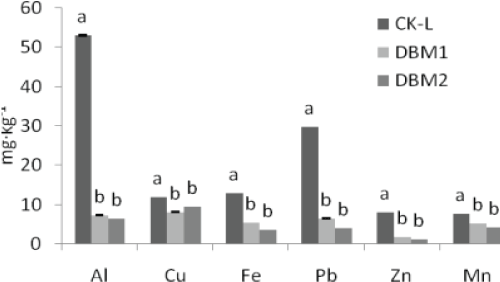 |
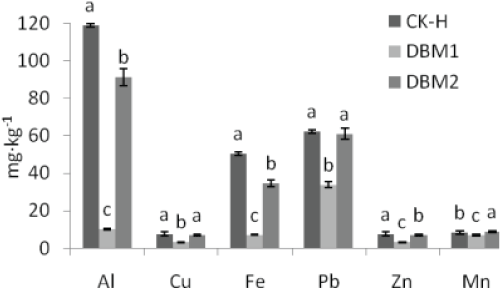 |
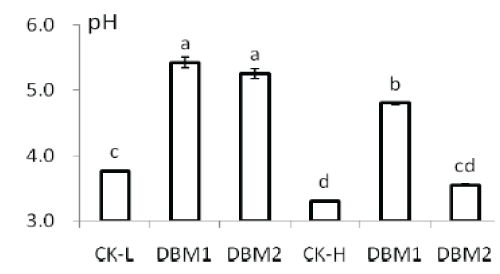 |
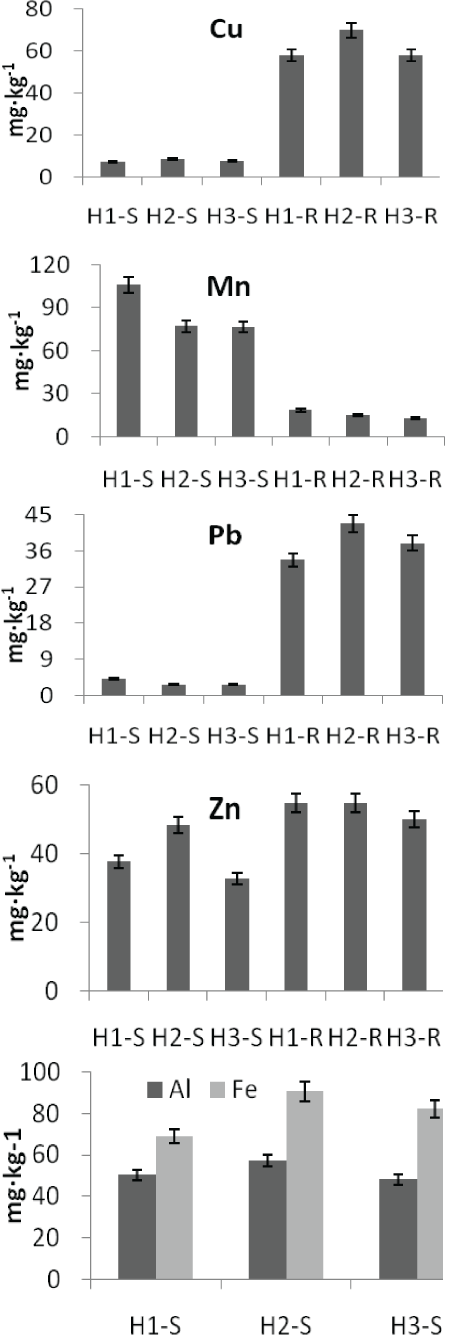 |
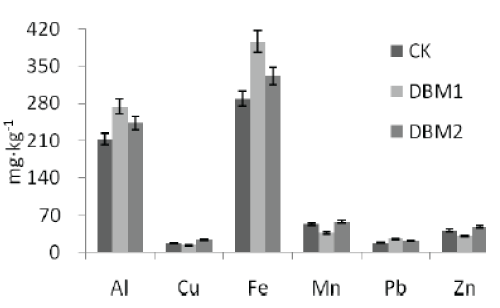 |
| Figure 1a | Figure 1b | Figure 2 | Figure 3 | Figure 4 |
Relevant Topics
- Anaerobic Biodegradation
- Biodegradable Balloons
- Biodegradable Confetti
- Biodegradable Diapers
- Biodegradable Plastics
- Biodegradable Sunscreen
- Biodegradation
- Bioremediation Bacteria
- Bioremediation Oil Spills
- Bioremediation Plants
- Bioremediation Products
- Ex Situ Bioremediation
- Heavy Metal Bioremediation
- In Situ Bioremediation
- Mycoremediation
- Non Biodegradable
- Phytoremediation
- Sewage Water Treatment
- Soil Bioremediation
- Types of Upwelling
- Waste Degredation
- Xenobiotics
Recommended Journals
Article Tools
Article Usage
- Total views: 11379
- [From(publication date):
March-2016 - Apr 03, 2025] - Breakdown by view type
- HTML page views : 10374
- PDF downloads : 1005
